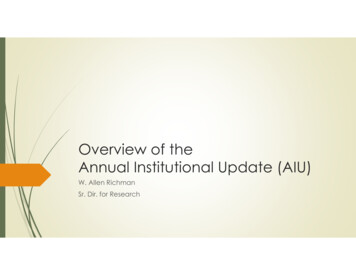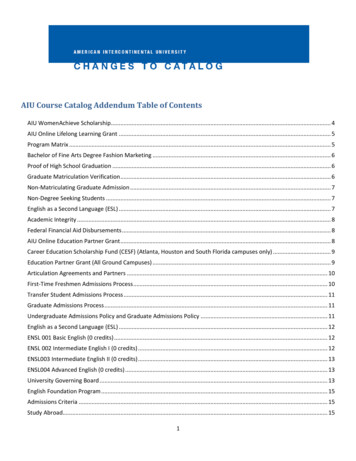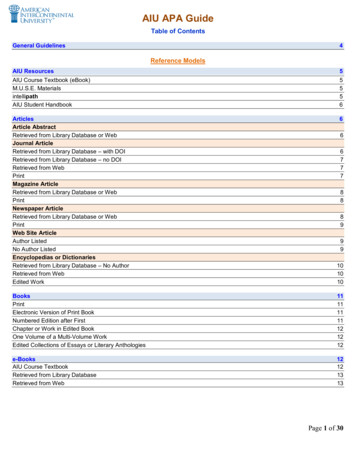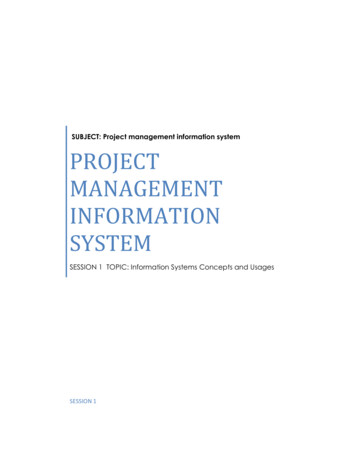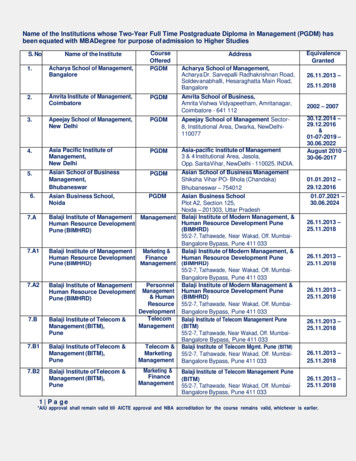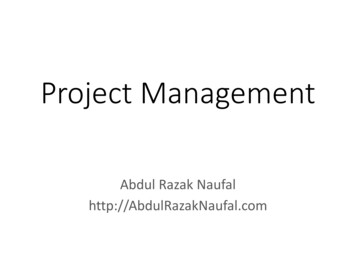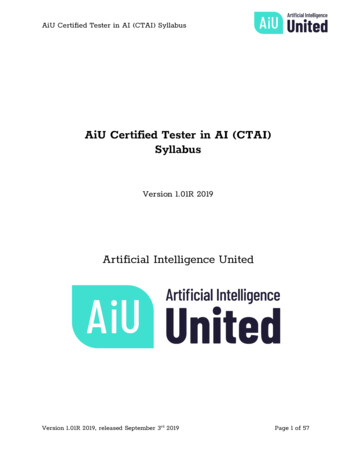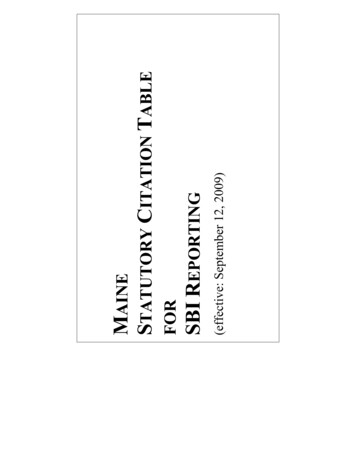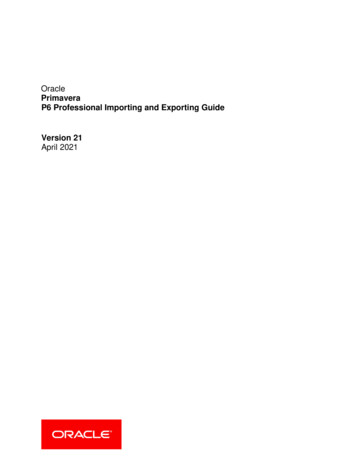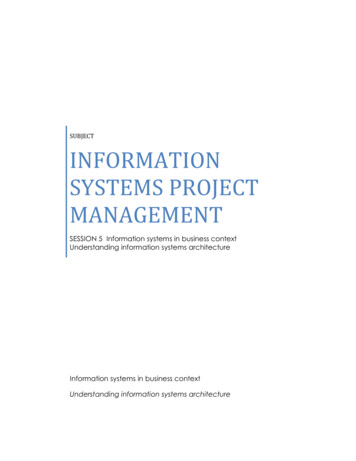
Transcription
SUBJECTINFORMATIONSYSTEMS PROJECTMANAGEMENTSESSION 5 Information systems in business contextUnderstanding information systems architectureInformation systems in business contextUnderstanding information systems architecture
Session 5Information systems in business contextUnderstanding information systems architectureEnterprise architecture and system development defines the broad structure ofa system, consisting of its parts, their interrelationships and other visibleproperties. It consists of constituent units such as business architecture,technology architecture and information systems architecture.Taken together, they ensure that an organization:Meets stakeholder needsAligns its IT with business purposesIntegrates all departmentsPromotes securityBrings about data integrity and consistency andReduces duplication and is cost-effective.Collaborative effort through enterprise architecture engagementMere enunciation of the architecture tasks in an organization is not enough.These objectives can be put into practice only with a proper engagementprocess. This helps to establish the rules of governance and the ways in whichthe architecture process can be managed. Enterprise architectureengagement ensures that EA standards and guidelines are put into effect. It setsout rules specifying ways in which Enterprise Architecture and strategic planningcan be carried out by projects. It is an intrinsic part of enterprise architecturegovernance process.For effective engagement, interaction between the project team and thearchitects is critical. It includes various steps such as developing EA standards,carrying out project activities and performing compliance and conflictresolution activities.It is a process by which the key stakeholders are involved in the company's ITand business goals. The key stakeholders in the governance process include the1
company's overall management, business unit management and projectmanagement team.Transparent decision-making in the enterprise architecture governance processGovernance is the process that ensures that organizational changes are movingin the desired direction, implementing the goals and objectives. Enterprisearchitecture governance process may consist of clearly spelled or enforcedrules or can be broad declaration of IT principles. It helps in creatingaccountability and achieving an organization's IT vision.Enterprise architecture engagement is an important component of thegovernance process. A collaborative information systems architecturerepresenting all stakeholders will be more effective and successful for theorganization.Enterprise architecture planning: key to successWhile enterprise architecture (EA) defines what needs to be done, planningdefines when Enterprise Architecture framework will be implemented. Enterprisearchitecture planning is the process of defining architecture for the use ofinformation in support of the business and the plan for implementing them. In atop-down approach, EA approaches the business processes plan, develops theIT plan or the applications plan and a plan to better align business with IT, calleda functional plan. Planning EA is critical to a company's performance. It canbenefit an organization in several ways: identifies gaps between baseline andtargeted states and recommends a sequencing plan to bridge the gap, helps ininformation sharing across the board and helps to track performance andminimize overall costs.Enterprise architecture life cycle explainedLife cycle is the basic planning format applied to enterprise architecture andstrategic planning . Within an enterprise architecture life cycle (EALC), differentactivities in the project are implemented in a timely and effective manner.2
There are several activities involved in enterprise architecture planning. First is toenvision and define the scope of the architecture environment. Second is toidentify key stakeholders. Third is to create a business case for systems and finallyto create the project and evaluate and maintain it.The various steps in an EALC are: EA development, portfolio management,project management, solution delivery and organization change management.These are the broad areas that must be looked into in order that enterprisearchitecture and system development go hand in hand.Enterprise architecture and system development ensure mutual coexistenceAll large companies plan, develop, test and install software systems to rely ontheir information and data needs. A system is essentially a set of processes bywhich an organization achieves its objectives. No system functions in a vacuum.They coexist with numerous other systems in an organization. Enterprisearchitecture and system development is concerned with the fact that everysystem in an enterprise must not only fit in, but should also reflect the strategyand vision of the business.Within an enterprise architecture life cycle, a given application must bedeveloped so as to take advantage of a shared infrastructure. It should notadversely affect other systems in an organization.Since information systems are prevalent in almost every aspect of modernbusiness and are required to achieve today’s business strategies, it is importantto understand the wider business context of information systems as well as howthey should be designed to reach sound technical performance and interactionqualities.Modern information systems do not have to be limited to the standard desktopcomputer or terminal and can designed for user needs of mobile workers orbusinessmen, which places new demands on design work and interactionmodels. Likewise, many of the bread-and-butter systems are either already built3
and exist as Legacy systems or are nowadays ICT commodities bought in theform of COTS, Commercial off-the-shelf, like Enterprise Resource Planning (ERP)systems, Supply Chain Management (SCM) systems, Business ProcessManagement Systems (BPMS), Enterprise Decision Management (EDM) systems,and so on. These are then deployed in the organisation. Thus, the role of IS andISD changes to accommodate new use patterns and business processes andstrategies in a world of agile and global e-Businesses.What does the programme offer?The overall goal of the programme is to provide students with an advancedunderstanding of these aspects of IS and ISD. Following this comprehensive goal,theoretical concepts, models and tools will be compared with real and complexproblems in IS and ISD in order to train students in advanced problem solving.The programme also aims at introducing, explaining and applying themethodological aspects of studying ISD.The programme is capabilities-driven which means that after completing theprogramme graduates have specific valuable IS design capabilities and skills.The programme serves to provide students with deepened and thoroughknowledge of IS theories, concepts, techniques and their applications.Graduates are expected to demonstrate the skills and ability to:design IS in order to achieve improvements and innovative change inorganisations and societyapply theories, design methods, and tools for the development of ISparticipate in and manage IS-related change and innovation projects innational and international contextsdeploy IS and IT in organisations and business activitiesplan, carry out and report design and social science investigations and studiesSince information systems (IS) are prevalent in almost every aspect of modernbusiness and are required to achieve today’s business strategies, it is importantto understand the wider business context of information systems, as well as howthey should be designed to reach sound technical performance and interactionqualities. Modern information systems do not have to be limited to the standarddesktop computer or terminal and can be designed for user needs of mobile4
work- ers or business people, which places new demands on design work andinteraction models. Likewise, many of the bread-and-butter systems are eitheralready built and exist as legacy systems, or are nowadays information andcommunication technologies (ICT) commodities bought in the form of COTS(commercial off-the-shelf) like enterprise resource planning (ERP) systems, supplychain management (SCM) systems, business process management systems(BPMS), enterprise decision management (EDM) systems, and so on. These arethen deployed in the organisation.Thus, the role of information systems and information systems development ischanging to accommodate new usage patterns, business processes andstrategies in a world of agile and global e-businesses. The overall goal of theprogramme is to provide students with an advanced understanding of theseaspects of IS and ISD. Following this comprehensive goal, theoretical concepts,models and tools will be compared with real and complex problems in IS andISD in order to train students in advanced problem solving. The programme alsoaims at introducing, explaining and applying the methodological aspects ofstudying ISD.The programme is capabilities-driven, which means that upon completion of theprogramme the graduates will have specific valuable IS design capabilities andskills. The programme serves to provide students with deepened and thoroughknowledge of IS theories, concepts, techniques and their applications.Graduates are expected to demonstrate the skills and ability to:design IS in order to achieve improvements and innovative change inorganisations and societyapply theories, design methods, and tools for the development of ISparticipate in and manage IS-related change and innovation projects innational and international contextsdeploy IS and IT in organisations and business activitiesplan, carry out and report design and social science investigations and studiesWhen you apply for this programme, you must also submit supportingdocuments such as CV, letters of recommendation and a statement of purposein your application package.5
Career prospectsThis programme targets students seeking to pursue careers in information andbusiness architecture and design. Graduates of the programed are highlysought after by employers, and will be able to work both nationally andinternationally as, for example, IS/IT consultants, business and system analysts, ISdesigners or IS/IT project managers. It is evident that the labour market valuesgraduates that have a combination of business knowledge and IS designknowledge.Former students have found work at companies such as Tetra Pak, Capgemini,IBM, Microsoft, Goldman Sachs, Sony Mobile, Ericsson, Price WaterhouseCoopers, IKEA, the United Nations, Accenture and Ernst & Young.More information can be found atProject Market ValueMaster’s team projects are an incredible opportunity for firms and not-for-profitsto engage a team of highly educated and experienced professionals that havebeen vetted by a top ranked academic program. Each team will contribute atleast 450 work hours towards the client project. Using very moderatecontracting numbers, this is equivalent to 35,000 in consulting value, plus anopportunity to observe potential employees in action.Student Team ProfileThe faculty selected student teams typically have five (5) student members whoare selected so that each team will have a balanced mix of skills andtalents. These students will have the benefit of a rigorous semester of coretraining in database, data communications and networking, enterprise datamanagement, and business communications. In addition, they may also beenrolled in courses in business intelligence, web analytics and businessfoundations.Students have outstanding academic records and substantial prior workexperience consistent with admission to a MIS program. Past experience andeducation, Eller education, and faculty mentoring result into formidableprofessional teams that can be leveraged to create significant value for theclient.Client Profile6
The success of the projects depends on the activeengagement and commitment of clients and the student teams during theproject scope formation, execution, and closing. Clients are asked to:Provide any data, resources, and background information necessary tocomplete the projectProvide a primary contact person(s) that are available for regular status reports,consultation on issues that may arise, andAttend a final presentation of the project reportThe Eller MIS department is committed to a “no surprises” engagement for theclient and constructive feedback for the students. This mandates effectivebilateral communication throughout the engagement.Examples of ProjectsTechnology selection and evaluationFeasibility studies and proof of concept for new products and servicesData analytics projects related to demand estimation, diagnostic systems,marketCompetitive intelligence capture and analysis using advanced web crawlersand analyticsWork flow analysis and design, process improvementBusiness intelligence/OLAP analysis and designWeb-based portals and dashboardsProject management information systemFrom Wikipedia, the free encyclopedia7
A project management information system (PMIS) is the coherent organizationof the information required for an organization to execute projects successfully.A PMIS is typically one or more software applications and a methodical processfor collecting and using project information. These electronic systems "help [to]plan, execute, and closeproject management goals."[1] PMIS systems differ inscope, design and features depending upon an organisation's operationalrequirements.Contents1 PMIS PMBOK 4th edition definition2 Project management information system software2.1 Characteristics of a PMIS Software3 Relationship between a PMS and PMIS4 References5 External linksPMIS PMBOK 4th edition definition[Project management information system (PMIS) [Tool]. The Project ManagementInformation System (PMIS), part of the enterprise environmental factors, providesaccess to an automated tool, such as a scheduling software tool, aconfiguration management system, an information collection and distributionsystem, or web interfaces to other online automated systems used during theDirect and Manage Project Execution effort.Project management information system software[At the center of any modern PMIS is software. Project management informationsystem can vary from something as simple as a File system containing MicrosoftExceldocuments, to a full blown enterprise PMIS software.Characteristics of a PMIS Software[The methodological process used to collect and organize project informationcan match normalized methodologies such as Project ManagementProfessional or PRINCE2.8
A PMIS Software supports all Project management knowledge areas such as :Integration Management, Project Scope Management, Project TimeManagement, Project Cost Management, Project Quality Management, ProjectHuman Resource Management, Project Communications Management, ProjectRisk Management, Project Procurement Management, and Project StakeholdersManagement.[2]A PMIS Software is a multi-user application, and can be cloud based or hostedon-premise.9
systems, Supply Chain Management (SCM) systems, Business Process Management Systems (BPMS), Enterprise Decision Management (EDM) systems, and so on. These are then deployed in the organisation. Thus, the role of IS and ISD changes to accommodate new use patterns and business processes and strategies in a world of agile and global e-Businesses.
